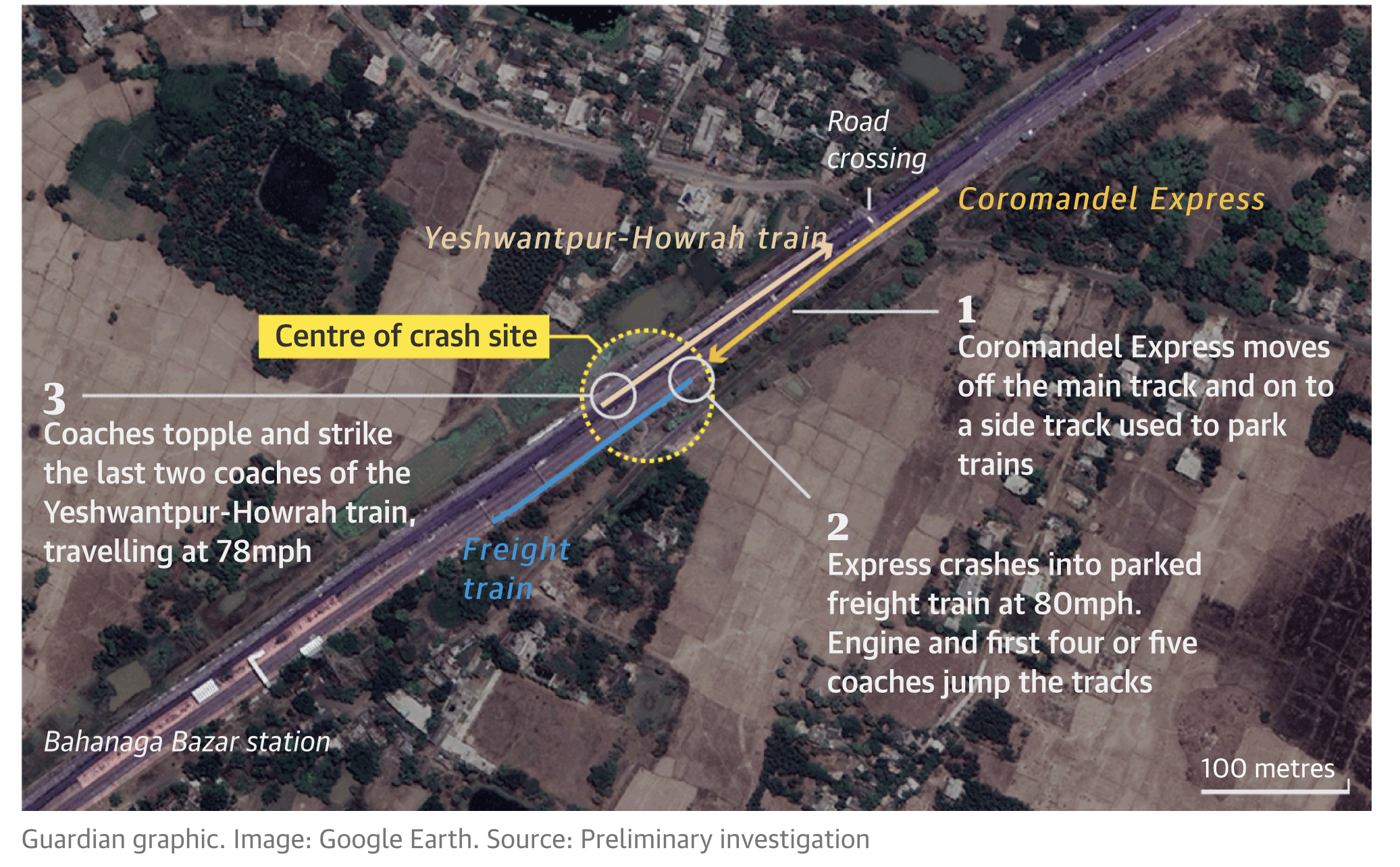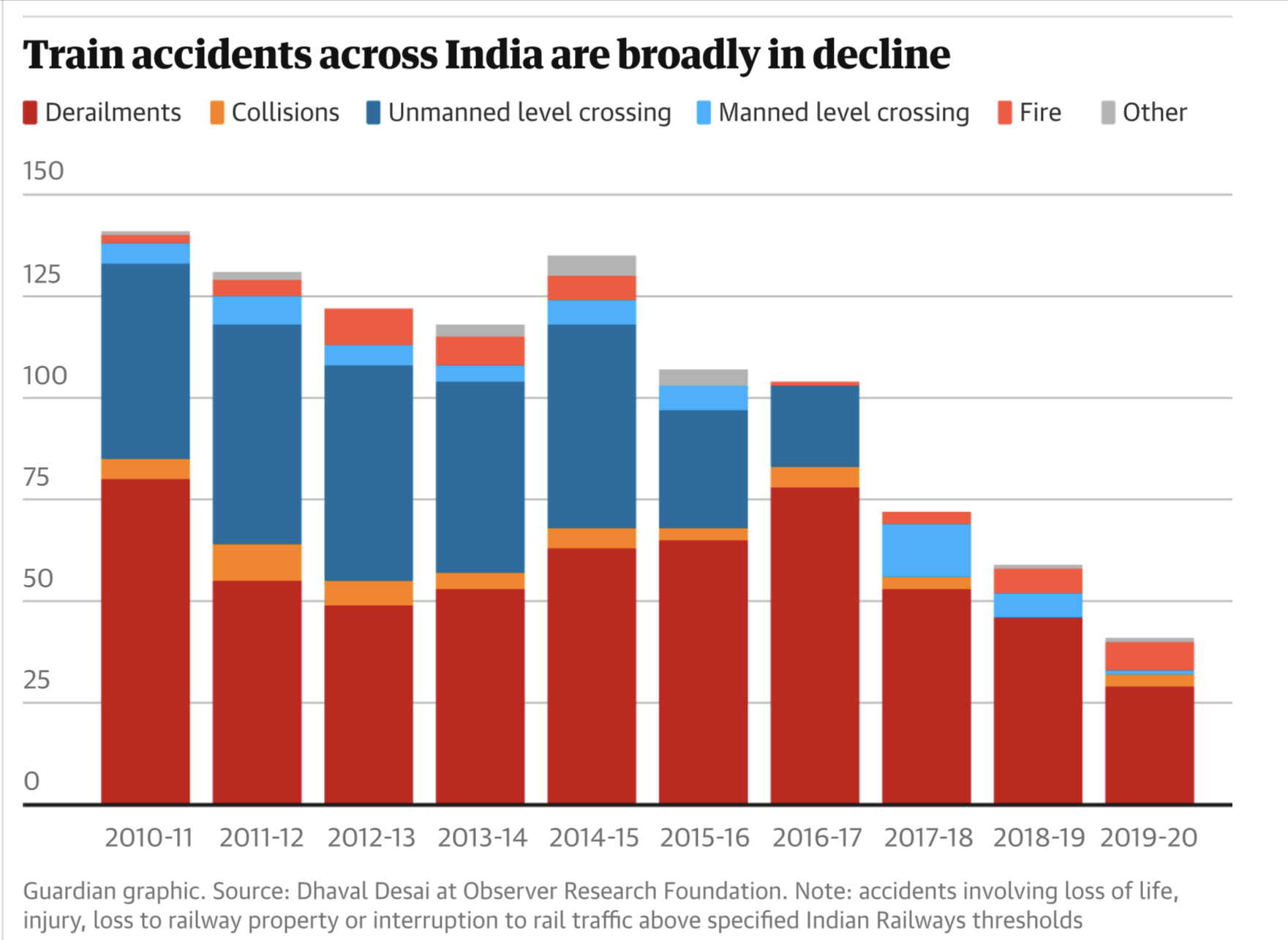ForumIAS announcing GS Foundation Program for UPSC CSE 2025-26 from 19 April. Click Here for more information.
Contents
- 1 Introduction
- 2 About the recent train accident and its reason
- 3 What are the previous train accidents due to lapses in Indian railway safety?
- 4 Why the safety of Indian Railways is paramount?
- 5 What are various government initiatives to address the Indian railway safety concerns?
- 6 What are the challenges in ensuring the safety of Indian railways?
- 7 What should be done?
| For 7PM Editorial Archives click HERE → |
Introduction
The issue of Indian railway safety has come under scrutiny following a recent Balasore tragic accident. This incident has raised concerns about the lapses in safety measures within the Indian railway system. It highlights the urgent need for comprehensive reforms and improved safety protocols to ensure the well-being of passengers and prevent such devastating accidents in the future.
About the recent train accident and its reason

In a recent train accident in Balasore, Odisha, three trains collided, resulting in a high number of casualties and injuries. The collision occurred when the Chennai-bound Coromandel Express veered off its track and crashed into a stationary goods train. The impact caused the passenger train’s coaches to derail and hit another passenger train travelling in the opposite direction.
The preliminary investigation suggests that a technical glitch with the signalling system may have been the reason for the accident. The Railways authorities have identified the root cause and responsible parties and are taking steps to rectify the issue. This tragic incident highlights the ongoing challenges of rail safety in India and the need for improvements to prevent such accidents in the future.
What are the previous train accidents due to lapses in Indian railway safety?
According to the National Crime Records Bureau, an average 23,000 people died every year between 2010 and 2021 in railway accidents. These accidents were due to,

Derailments: Derailments have been a major cause of train accidents in India. Lapses in safety protocols, track maintenance, and failure to identify and rectify track defects have resulted in derailments. For example, the derailment of the Puri-Haridwar Utkal Express in 2017, which claimed 23 lives and injured many, was attributed to negligence in track maintenance.
Collisions: Train collisions have occurred due to lapses in signalling systems, human errors, and failure to maintain safe distances between trains. One such incident was the collision between the Gorakhdham Express and a halted goods train in Uttar Pradesh, in 2014, resulting in a high number of casualties and injuries.
Level crossing accidents: Lapses in ensuring the safety of level crossings have led to accidents involving trains and road vehicles. Failure to eliminate manned level crossings, inadequate warning systems, and negligence in adhering to safety procedures have contributed to such accidents. For instance, in 2011, 38 people have been killed and 17 others injured in a train-bus collision in the Kanshiramnagar district of Uttar Pradesh.
Signal failures: Malfunctioning or improper signalling systems have been responsible for train accidents. Inadequate maintenance, faulty equipment, and human errors in signalling operations have resulted in collisions and other mishaps. The collision of two trains in Gaisal, West Bengal (1999), occurred due to a signalling error.
Overcrowding and overspeeding: Overcrowding of trains beyond their capacity and overspeeding have also led to accidents. Lack of proper crowd management and failure to enforce speed limits have been significant safety concerns. The 2018 Amritsar train accident, where a train struck a crowd watching a Dussehra event near the railway tracks, causing numerous fatalities, highlighted the risks associated with overcrowding.
| Read more: [Kurukshetra May Summary] Railway Connectivity – Explained, pointwise |
Why the safety of Indian Railways is paramount?
High volume of passengers: India is the fourth-largest rail network in the world at 68,043 km and almost 3.5 billion people travel on this network annually. With a massive population and millions of people relying on the railways for their daily commute, ensuring the safety of Indian Railways becomes crucial. The railways carry a significant volume of passengers, and any safety lapse can have catastrophic effects, as witnessed in past accidents.
Economic impact: Indian Railways is a crucial component of the country’s transportation infrastructure and plays a vital role in the economy. Any disruption or safety-related issues can lead to economic setbacks, affecting industries, businesses, and overall development.
Lifeline for economic migrants: Trains are the lifeline for a bulk of India’s poorer economic migrants. Their ability to move and improve their economic prospects has a positive impact on their home states through remittances. The economic survey used unreserved railway travel as a proxy for economic migration between 2011 and 2016 and concluded that the annual average inter-state migration was close to nine million.
Reputation and public trust: The safety of Indian Railways is essential to maintain the public’s trust and confidence in the system. Instances of accidents and safety lapses can erode the reputation of the railways and result in passengers losing faith in the reliability and security of train travel.
International comparison: Safety standards in Indian Railways are often compared with those of developed countries. Countries like Japan, China, and several European nations have demonstrated that high safety standards are achievable. The focus on safety is not only crucial for passenger well-being but also to align with global best practices and enhance India’s image on the international stage.
Connectivity: Indian Railways is a lifeline for connectivity, ensuring people from various regions can travel and access opportunities for economic growth. Safety is crucial for fostering economic development, enabling the seamless movement of goods, and attracting investments.
Regulatory compliance: Safety is a regulatory requirement and a legal obligation for Indian Railways. Adhering to safety protocols and regulations is not only necessary to prevent accidents but also to comply with national and international standards, ensuring the railways operate within a framework that safeguards the well-being of passengers.
What are various government initiatives to address the Indian railway safety concerns?

Kavach system: KAVACH is an indigenously developed Automatic Train Protection(ATP) System for Indian Railways.
Rashtriya Rail Sanraksha Kosh (RRSK): The government initiated the RRSK in 2017-18, a dedicated fund aimed at carrying out safety-related work in a systematic manner.
Project Mission Raftar: It is an Indian Railway project, introduced in the Railway Budget of 2016-17 and approved by NITI Aayog in 2017. The goal is to double the average speed of freight trains and increase passenger train speed by 50%. While the focus is on improving speed, it indirectly contributes to safety by reducing travel time and potentially minimizing the risks associated with prolonged journeys.
Upgradation of infrastructure: The government has been investing significant funds in the modernization and upgradation of railway infrastructure. This includes the electrification of railway lines, the expansion of rail networks, and the introduction of high-speed and ultra-high-speed lines, such as the Vande Bharat Express.
Implementation of safety measures: Efforts have been made to implement safety measures across the railway network. These include the installation of fire and smoke detection systems in coaches, the provision of fire extinguishers, and the development of technologies like the Kavach application that aids locomotive pilots in triggering the brake system automatically.
Elimination of manned level crossings: The government has been working towards the elimination of manned level crossings, which are prone to accidents. Efforts are being made to replace them with underpasses, overpasses, and other safety measures to enhance railway safety.
Audit reports and recommendations: The Comptroller and Auditor General of India (CAG) periodically conducts audits of Indian Railways, identifying shortcomings and making recommendations to address safety concerns. These reports serve as a basis for corrective actions and improvements in safety protocols.
| Read more: Vande Bharat trains: Potential and Challenges – Explained, pointwise |
What are the challenges in ensuring the safety of Indian railways?
Technical glitches and system failures: The occurrence of technical glitches and system failures, such as the electronic interlocking error in the Balasore train crash, poses a significant challenge to ensuring the safety of Indian Railways. These issues can lead to signalling errors, track misalignment, and other critical safety hazards.
Funding constraints and prioritization: The allocation and utilization of funds for safety-related works face challenges. The decline in funding for track renewal, diversion of funds to non-priority tasks, and constraints in the Rashtriya Rail Sanraksha Kosh pose obstacles to effectively addressing safety concerns.
Inadequate maintenance and inspections: The CAG audit reports highlight shortcomings in maintenance activities, inspections, and track renewal processes. Shortfalls in inspections, failure to submit or accept inquiry reports after accidents, and declining funding for track maintenance contribute to safety concerns.
Congestion and overcrowding: The Indian Railways network experiences severe congestion, especially on major trunk routes, leading to overcrowded trains and increased risks. The high volume of passengers and inadequate capacity utilization can impact safety protocols and create challenges in managing passenger flow during emergencies.
Compliance and implementation: Ensuring compliance with safety protocols and timely implementation of safety measures across the vast railway network is a complex challenge. The need for strict adherence to scheduled timelines for accident inquiries, acceptance of inquiry reports, and effective monitoring mechanisms is emphasized in the reports.
Human Factors: Human error, such as incorrect setting of points, mistakes in shunting operations, and overspeeding, has been identified as a significant factor contributing to train accidents.
What should be done?
Conduct thorough investigations: It is essential to conduct comprehensive and timely investigations into train accidents to identify the root causes and determine accountability. This includes submitting and accepting inquiry reports within prescribed timelines and ensuring that the findings are made public for analysis and discussion.
Strengthen maintenance practices: Prioritize track maintenance, inspections, and infrastructure upgrades to prevent derailments and ensure safe operations. Implement mechanized methods of track maintenance and leverage improved technologies to enhance the efficiency and effectiveness of maintenance activities.
Allocate sufficient funding: Ensure adequate funding for safety-related works, including track renewal, signalling systems, and infrastructure upgrades. Proper utilization of funds from initiatives like the Rashtriya Rail Sanraksha Kosh (RRSK) should be ensured to address safety priorities effectively.
Enhance staffing and training: Address staffing shortages in safety-related positions and provide comprehensive training programs for staff members involved in train operations. Focus on improving skills, knowledge, and adherence to safety protocols to minimize human errors.
Implement advanced technologies: Embrace advanced technologies, to enhance safety monitoring, early detection of faults, and real-time decision-making.
Prioritize safety as a culture: Foster a safety culture across the Indian railways by emphasizing the importance of safety at all levels. Encourage reporting of safety concerns, promote safety awareness and education among staff and passengers, and instil a sense of responsibility for safety in every aspect of railway operations.
Sources: Live Mint, Business Standard (Article 1 and Article 2), Times of India (Article 1, Article 2, Article 3 and Article 4), Indian Express (Article 1 and Article 2) and The Hindu
Syllabus: GS 3: Economic development: Infrastructure: Energy, Ports, Roads, Airports, Railways etc.




